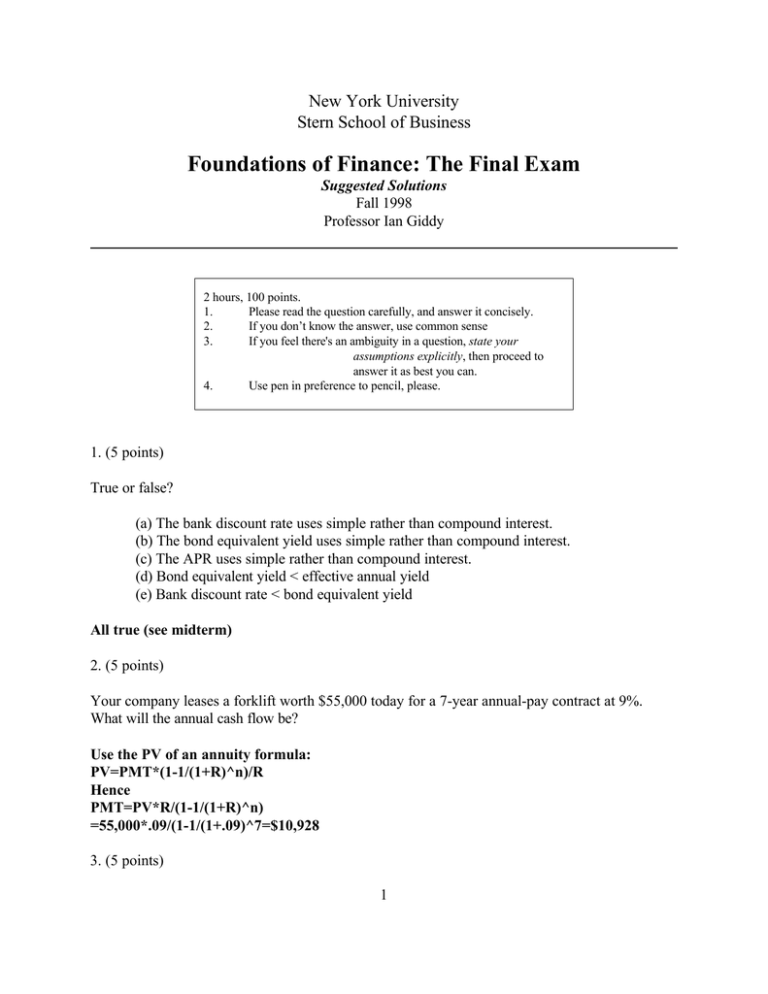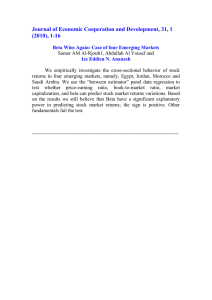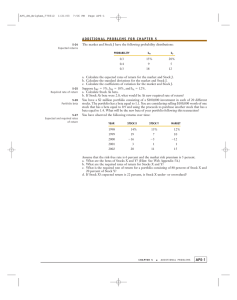Foundations of Finance: The Final Exam
advertisement

New York University
Stern School of Business
Foundations of Finance: The Final Exam
Suggested Solutions
Fall 1998
Professor Ian Giddy
2 hours, 100 points.
1.
Please read the question carefully, and answer it concisely.
2.
If you don’t know the answer, use common sense
3.
If you feel there's an ambiguity in a question, state your
assumptions explicitly, then proceed to
answer it as best you can.
4.
Use pen in preference to pencil, please.
1. (5 points)
True or false?
(a) The bank discount rate uses simple rather than compound interest.
(b) The bond equivalent yield uses simple rather than compound interest.
(c) The APR uses simple rather than compound interest.
(d) Bond equivalent yield < effective annual yield
(e) Bank discount rate < bond equivalent yield
All true (see midterm)
2. (5 points)
Your company leases a forklift worth $55,000 today for a 7-year annual-pay contract at 9%.
What will the annual cash flow be?
Use the PV of an annuity formula:
PV=PMT*(1-1/(1+R)^n)/R
Hence
PMT=PV*R/(1-1/(1+R)^n)
=55,000*.09/(1-1/(1+.09)^7=$10,928
3. (5 points)
1
Philips issued a 4-year 8% straight Eurobond a year ago. It's now trading at an 8% yield. What's
its modified duration?
Duration = time-weighted PV of cash flows/Price
Modified duration=Duration/(1+yield)
Duration= [1(80)(.926)+2(80)(.857)+3(1080)(.794)]/[80(.926)+80(.857)+1080(.794)]
= 2771/996
= 2.78
Modified duration = 2.78/(1+.08)=2.56
4. (5 points)
Sherman Bank pays 5 percent simple interest, paid semi-annually, on its savings account balances,
while Tecumseh Bank pays 5 percent interest compounded annually. If you made a $10,000
deposit in each bank, how much additional money would you earn from your Tecumseh Bank
account at the end of 10 years?
Simple: PV*(1+Rn)=10,000*(1+.025*20)=15,000
Compound: FV=PV*(1+R/m)^(n*m) =10000*(1+.05)^10=16,289
16,289-15,000=$1,289
5. (5 points)
You work at Bell Atlantic at an annual salary of $102,000, paid monthly. You are offered a
severance package that will pay 6 months salary now or you and your heirs $7000 per year
forever. If your required return is 12 percent, which should you choose, and why?
Answer: take the perpetuity!
6 months salary = 6(102,000/12) = $51,000
Perpetuity:
PV=PMT*(1/r) (present value of a perpetuity)
=7000/.12
= $58,333
6. (5 points)
You own a stock portfolio invested 10% in Guidant (beta 1.2), 20% in Akzo-Nobel (beta 0.6),
30% in Ciba Speciality Chemicals (beta 1.5), and the remainder equally divided between treasury
bills and the Fidelity Market Index Fund. What is the portfolio beta?
Portfolio beta is the weighted average of the components’ betas, including T-bills (beta=0)
and the index fund (Beta=1).
2
Portfolio beta=.10(1.2)+.20(0.6)+.30(1.5)+.20(0)+.20(1)=0.89
7. (5 points)
You have been hired to design a global portfolio based on two funds, Korea Fund and Con Ed.
The standard deviation of returns on KF is 20% and on Con Ed 5%. They have a correlation
coefficient of 0.30. KF's expected return is 22% and that of Con Ed 8%.
In order to minimize your client’s portfolio's variance, how much should you allocate to Con Ed?
Weight (Con Ed) = [(SDk)^2 - (SDk)(SDc)(CorrK,C)]
--------------------------------------------[(SDc)^2 + (SDk)^2 - 2(SDc)(SDk)(CorrK,C)]
Weight (Con Ed) = [(.20)^2 - (.05)(.20)(.3)]
--------------------------[(.05)^2 + (.20)^2 - 2(.05)(.20)(.3)]
= 101.37% (implying you short some Korea Fund)
8. (5 points)
Suppose the rate on government treasuries is 8% and the expected return on the market is 16%. If
the equity of Yahoo, Inc. has a beta of 1.7, what is its expected return based on the CAPM?
E(r)=RF+Beta[E(rm)-RF]
=.08+1.7(.16-.08)=21.6%
9. (5 points)
Trump’s Kingdom has a beta of 1.59 and an expected return of 25%. Sears has a beta of .44 and
an expected return of 12%. If the rate on T-bills is 6% and the market risk premium is 11.3%,
what are the reward-to-risk ratios of the two stocks? Which would you buy? (Or sell short?)
Reward-to-risk=[E(r)-RF]/Beta
Market: 11.3%/1=0.1130
Trump: 19%/1.59=.1195
Sears: 6%/.44=.1364
So: Buy Sears (and perhaps short the market)
10. (5 points)
Suppose IBM is able to borrow in the 6-month Canadian banker's acceptance market at a rate of
12%. The current exchange rate is C$1=US$0.72. The 182-day forward rate is $0.70. Would this
3
be cheaper than borrowing in the US at 6.2%?
US is dearer at 6.2%
Canadian alternative:
Effective Rus=(1+.12/2).70/.72-1=.0306 ie 6.12%
So borrow in Canada.
11. (5 points)
Suppose IBM’s pension fund is able to invest in $25 million in 6-month Russian treasuries
yielding 40%, less a 5% withholding tax. The current exchange rate is US$1=R100. The 182-day
forward rate is $1=R125. If the Nikkei index rises 15% and the ruble falls to R135, what is the
effective rate of return an unhedged investment in Russia would produce?
Unhedged alternative:
$25*100Rubles earn 95% of 20% so at end of 6 months: 2500*.95*1.2=2850
2850Rubles/135=$21.11million
Holding period return = (21.11-25)/25=15.56%
Annualized: (1-.1556)^2-1=-.2869 ie 28.69% negative return.
12. (5 points)
Your uncle Percy from Poughkeepsie buys a 5.5%, 20-year municipal bond with annual coupon
payments. It is priced to yield him 10% taxable equivalent. If Percy’s tax bracket is 33%, what is
the bond's price?
Remember that the municipal tax exemption applies to interest income but not to capital
gains. So Price (P) has two components:
P=[Coupon/(1-Tax rate)]{[1-1/(1+Y)^n]/Y} + 1000[1/(1+Y)^n]
P=[55/(1-.33)]{[1-1/(1+.10)^20]/.10} + 1000[1/(1+.10)^20]
=698.87+148.65
=$847.52
(or $84.75)
13. (15 points)
Giddy’s Online Flagellation, Inc, is expected to have EPS in the upcoming year of $6.00. The
expected ROE is 18%. An appropriate required rate of return on the stock of the privately held
company is 10% over the 4% treasury rate, based on its estimated beta of 1.35. If the firm has a
plowback ratio of 70%, then
(a) its growth rate of dividends should be:
(b) its next annual dividend should be:
4
(c) if it did an IPO, its 10,000 shares should be worth:
(a) g = .18(.70)=.1260 or 12.6%
(b) D1=6.00(1-.70)=$1.80 per share
(c) V0=[6.00(1-.70)]/[(.10+.04)-.18(.70)]=$128.57 per share or $1,285,700
14. (5 points)
Pittsburgh Strip, Inc, is expected to pay a dividend of $4.20 in the upcoming year. Dividends are
expected to grow at the rate of 8% per year. The risk free rate is 4% and the expected return on
the market portfolio is 14%. Investors use the CAPM to compute the market capitalization rate
on the stock, and the constant growth DDM to determine the intrinsic value of the stock. The
stock is trading in the market today at $84.00. What is the estimated beta of Pittsburgh Strip?
k=E(r)=D1/P0+g
k=4.20/84+.08=.1300
From CAPM, E(r)=RF+Beta[E(rm)-RF]
So Beta=[E(r)-RF]/[E(rm)-RF]
Beta=(.13-.04)/(.14-.04)=.90
15. (5 points)
Ronnigan Research is expected to pay a dividend in year 1 of $3, year 2 $2, and year 3 $1. After
the third year, dividends are expected to decline at the rate of 2% per year. Investors require a
rate of return of 8% per annum. What should the stock be worth?
First find the value at end of year 3
V3 = [1.00(1+(-.02)]/(.08-(-.02))=9.80
Then find today's present value of all cash flows:
V0 = PV(3)+PV(2)+PV(1+V3)
= 3(.926)+2(.857)+(1+9.80)(.794)=13.06
16. (5 points)
Long Term Capital enters into a $10 million, 4-year interest-rate swap with Citi to hedge a
corporate bond investment by converting the fixed rate on the bond into a floating rate of Libor +
.35%. The bond yields Treasury + 1.90%. The swap rate is 8% vs quarterly Libor flat. 3-month
Libor is 6.5%.
A year later, Libor is 6% and the 3-year rate is 7.75%. How much money changes hands during
that quarter?
5
LTC, which wants to take its fixed receipts and exchange them for floating ones, needs a
swap in which it receives quarterly Libor and pays a fixed rate (quarterly payment of 8%
pa, ie 8%/4 each
quarter).
If, at one particular quarter, Libor is 6%, then
LTC pays Citi: Fixed rate - Libor
$10 million(8% fixed - 6% Libor)/4=$0.05m=$50,000 LTC pays to Citi
17. (5 points)
A call option on Juniper stock with an exercise price of $75 and an expiration date one year from
now is worth $5 today. A put option on the same company with an exercise price of $75 and one
year to expire is priced at $2.75. The interest rate is 8% and Juniper pays no dividends. What
should the stock price be?
From put-call parity,
C-P=S-E/(1+r), so by rearranging,
S=5.00-2.75+75/(1+.08)=71.69
18. (5 points)
In a particular year, The Pontorno Fund earned a return of 2% by making the following
investments in asset classes:
WEIGHT
Domestic
.10
International .90
RETURN
.11
.01
The return on the bogey portfolio was 5%, calculated as follows:
WEIGHT
US market (S& P Index)
.50
International (EAFA Index) .50
RETURN
.10
0
The contribution of security selection within asset classes to the total excess return was:
Excess return = .02-.05=-.03 or -3%
Contribution: (.11 - .10).10 + (.01 - 0).90 = .01 or 1%
6




